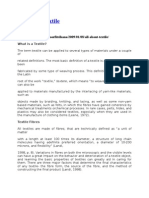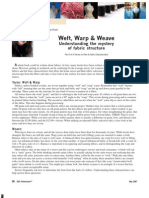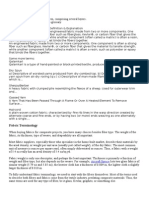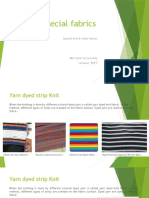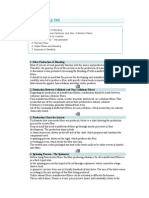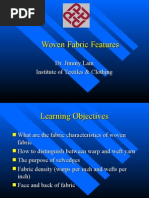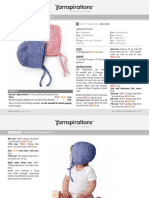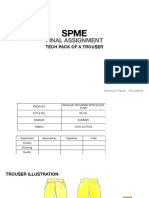0 ratings0% found this document useful (0 votes)
5 viewsHelpful textiles distinctions
The document explains the distinctions between fibers, fabric, cloth, weave, and finish in textiles. Fiber is the raw material, fabric is the textile made from fibers, cloth is a general term for fabric, weave refers to the pattern of interlacing threads, and finish involves treatments that enhance fabric properties. It highlights that while these terms are often used interchangeably in casual conversation, they have specific meanings in technical contexts.
Uploaded by
Alessio ColangeloCopyright
© © All Rights Reserved
Available Formats
Download as DOCX, PDF, TXT or read online on Scribd
0 ratings0% found this document useful (0 votes)
5 viewsHelpful textiles distinctions
The document explains the distinctions between fibers, fabric, cloth, weave, and finish in textiles. Fiber is the raw material, fabric is the textile made from fibers, cloth is a general term for fabric, weave refers to the pattern of interlacing threads, and finish involves treatments that enhance fabric properties. It highlights that while these terms are often used interchangeably in casual conversation, they have specific meanings in technical contexts.
Uploaded by
Alessio ColangeloCopyright
© © All Rights Reserved
Available Formats
Download as DOCX, PDF, TXT or read online on Scribd
You are on page 1/ 2
Not everyone is familiar with the technical distinctions between fibers,
fabric, cloth, weave, and finish, as these terms can sometimes be used
interchangeably in everyday conversation. However, people who work in
fashion, textiles, or interior design are more likely to understand and use
them correctly. Here's a breakdown of each term to clarify the differences:
1. Fiber:
Definition: The basic unit of raw material used to make fabric. It
can be natural (like cotton, wool, silk) or synthetic (like polyester,
nylon, acrylic).
Example: Cotton fiber is spun into yarn to make fabric.
2. Fabric:
Definition: A textile material that is produced by weaving, knitting,
or bonding fibers together. Fabric is the result of turning fibers into
a textile that can be used for making products like clothing or
upholstery.
Example: Denim, linen, and silk are all types of fabric.
3. Cloth:
Definition: This is essentially a synonym for fabric, though it is
often used to describe a piece of fabric that is not yet made into
something. "Cloth" can also refer to specific kinds of fabrics, such as
"woolen cloth" or "tablecloth." It's a bit more general and can be a
broad term for any fabric material.
Example: A piece of cotton cloth is ready to be sewn into a shirt.
4. Weave:
Definition: The pattern created when fibers (usually yarns) are
interlaced to form fabric. Different weaves produce fabrics with
distinct textures, drapes, and durability.
Examples:
o Plain weave: The simplest, with fibers woven over and under
in a grid-like pattern (e.g., basic cotton fabric).
o Twill weave: Diagonal pattern, as seen in denim or
gabardine.
o Satin weave: Creates a smooth, glossy surface (e.g., satin
fabric).
5. Finish:
Definition: The treatment or process applied to fabric after it is
woven or knitted to enhance its appearance, texture, durability, or
performance. Finishes can be mechanical (e.g., calendering to
smooth fabric) or chemical (e.g., waterproofing, flame retardant
treatments).
Example: A fabric might be given a soft finish to feel smoother or a
wrinkle-resistant finish for easy care.
So, to summarize:
Fiber is the raw material.
Fabric is the textile formed by weaving or knitting fibers.
Cloth is essentially fabric, though sometimes refers to a piece
before it’s made into a final product.
Weave refers to the interlacing pattern of threads in the fabric.
Finish refers to treatments that alter the fabric’s properties or
appearance.
While these terms might seem straightforward in a technical context,
they're often used interchangeably in casual conversation, which can lead
to some confusion. Most people likely have a general sense of what fabric
is, but may not be familiar with the more detailed distinctions between
these terms.
You might also like
- Crochet Pattern Mrand Mrs Bunny Krea Deluxe100% (9)Crochet Pattern Mrand Mrs Bunny Krea Deluxe43 pages
- Kenmore 158.1232 Sewing Machine Instruction Manual100% (1)Kenmore 158.1232 Sewing Machine Instruction Manual44 pages
- Eoj52jdur1azduktpypb Different Types of Fabrics 220813191820 7d5d1a08No ratings yetEoj52jdur1azduktpypb Different Types of Fabrics 220813191820 7d5d1a0843 pages
- Preparation For Textile Weaving: Learning ObjectivesNo ratings yetPreparation For Textile Weaving: Learning Objectives16 pages
- Bob Victoriano Flores 3 Year-Block 11 He 9-CspsNo ratings yetBob Victoriano Flores 3 Year-Block 11 He 9-Csps4 pages
- Textile Coloration for Garment Level4 2016No ratings yetTextile Coloration for Garment Level4 201661 pages
- 1.2fabric Selection For Garments & Properties100% (1)1.2fabric Selection For Garments & Properties7 pages
- NIFT Jodhpur Fabric Fundamentals: Mid Term AssignmentNo ratings yetNIFT Jodhpur Fabric Fundamentals: Mid Term Assignment36 pages
- Defination of Some Important Terms of TextileNo ratings yetDefination of Some Important Terms of Textile2 pages
- Upholstery Fabrics - A Guide to their Identification and Sales FeaturesFrom EverandUpholstery Fabrics - A Guide to their Identification and Sales FeaturesNo ratings yet
- Daljit Singh & Shreya Gupta End Term Assignment SPMENo ratings yetDaljit Singh & Shreya Gupta End Term Assignment SPME19 pages
- Arts of The Philippines: The Long Tradition of Hand Embroidery in Taal, Batangas100% (1)Arts of The Philippines: The Long Tradition of Hand Embroidery in Taal, Batangas3 pages
- Shirts Shifts and Sheets of Fine Linen 1st Edition Pam Inder - Read the ebook online or download it as you prefer100% (1)Shirts Shifts and Sheets of Fine Linen 1st Edition Pam Inder - Read the ebook online or download it as you prefer56 pages
- SeththeSlothPattern Final 1.14.25-Compressed100% (1)SeththeSlothPattern Final 1.14.25-Compressed9 pages
- Brother JX2517 Sewing Machine Instruction ManualNo ratings yetBrother JX2517 Sewing Machine Instruction Manual80 pages
- Novita Merino DK - Huoleton (Carefree) CardiganNo ratings yetNovita Merino DK - Huoleton (Carefree) Cardigan6 pages
- 00ENG JoyousBabyCardigan0 24monthsenglish MinNo ratings yet00ENG JoyousBabyCardigan0 24monthsenglish Min30 pages
- Final Assignment: Tech Pack of A TrouserNo ratings yetFinal Assignment: Tech Pack of A Trouser11 pages
- Tatreez Online: The Transformation of A Palestinian TraditionNo ratings yetTatreez Online: The Transformation of A Palestinian Tradition61 pages






















